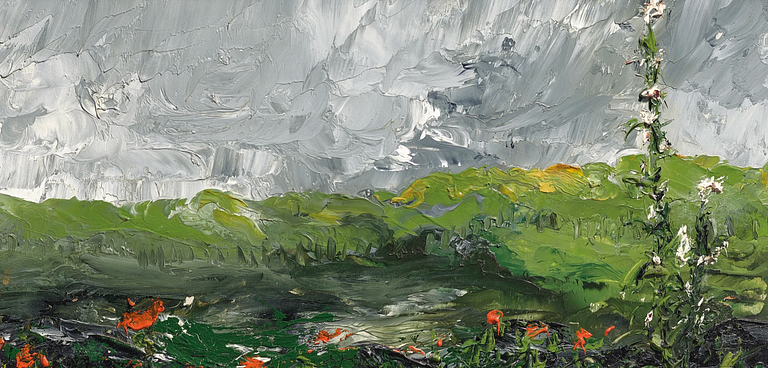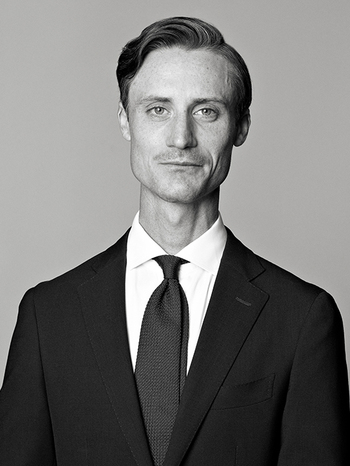Agnes de Frumerie
Landskap från Bretagne
Signerad A. de F. Bretagne samt Agnes de Frumerie a tergo. Pannå 24 x 18,5 cm.
Proveniens
Svensk privatsamling
Övrig information
Agnes de Frumerie, known above all as a sculptor and designer, was also an outstanding painter. This side, however, is little known. The majority of her known paintings, some twenty in all, are in Västergötlands museum in Skara, Sweden, forming part of a large bequest of her work according to her will. None of her paintings have been for sale in modern times and the paintings in Västergötland's museum have rarely been exhibited.
Agnes de Frumerie, nee Kjellberg, moved from Berlin to Paris in 1892 together with her mother, the pianist Sophie Uddman. In Paris, Agnes met the Swedish doctor Gustaf de Frumerie (1849-1936), whom she married in 1893. They couple settled in Montparnasse where they became part of the circle around the Swedish sculptor Ida Ericsson, married to the Norwegian-French composer William Molard. Molard’s home was open to artists, writers and composers and had become one of the most important cultural meeting places in Paris during the 1890s (See T. Millroth, Mollards Salon, 1995).
August Strindberg, who was in Paris from the autumn of 1894 - July 1896, was a frequent guest at the Molard’s. He had arrived in Paris in order to stage his play ”Le Père” at Theâtre de l’Œuvre, which premiered 12 December, with Gauguin, Rodin and other artists in the audience (during the general repetition he was portrayed by Maximilian Luce). Strindberg had been introduced to the Mollard’s by the Finnish painter Ester Kumlin (1873-1956), who in turn had been introduced to them by the Swedish painter Fanny Låstbom (1857-1926). In the autumn of 1894, Strindberg had resumed painting. During a few weeks, he painted 10 pictures, all imaginary coastal views, including the famous painting "High Lake" (Sven-Harry's Art Museum, Stockholm). Kumlin recalls that she saw his paintings in the room that the writer occupied in the boarding-house where she also resided (Exh. cat., Paris 1894. Finnish artists in the circle of Gauguin and Strindberg, Tikanoja Art Museum, 2 June -1 October 2017). Through Mollard Strindberg had been introduced to Paul Gauguin, who lived in the same house as Mollard. Gauguin had arrived in Paris from Tahiti during the autumn 1894 to arrange an exhibition of his works at the Durand-Ruel gallery. The exhibition was a failure and he decided to auction unsold pictures at Hotel Drouot. In January 1895, Strindberg's Le plaidoyer d'un fou, was published, written in French seven years earlier. The book instantly made him famous in France. Gauguin seized upon Strindberg’s meteoric fame and asked him to write the preface to the sale catalogue, which was also published in the daily press.
Strindberg and Gustaf de Frumerie were of the same age, and they shared an interest in natural science. Strindberg became a frequent guest in their home in Montparnasse. Strindberg was fond of Sofie Uddman's piano playing, which he felt had a calming effect on him. Agnes de Frumerie admired Gauguin’s paintings, and together with Strindberg they attended gatherings in Gauguin's studio.1 In 1895, she was given the honorable commission by Strindberg to model a bust of him (terracotta in Västergötland’s museum, bronze in Nationalmuseum). In 1896, Strindberg mentions the bust in a letter: "I have seen a hundred portraits of myself and asked: is that me? - I have only seen a bust of myself, about which I said: that's how I would like to look" (G. Ellison, Agnes de Frumerie, in the series Woman and artist, 1998, p. 26).
The present newly discovered work was painted in Brittany. Another painting by de Frumerie executed there is known, Evening atmosphere, Bretagne, in Västergötlands museum (Inv. No. 1M16-75592) (see fig).2 Ester Kumlin mentions that Scandinavian and French artist together visited Brittany on painting excursions (exh. cat., op. cit.). Although Agnes de Frumerie foremost was a sculptor and designer, she had initially studied painting at the Art Academy in Stockholm.3 The sparse comparative material makes it difficult, if not impossible, to date her paintings. However, it is likely that the present work was painted in the mid-1890s. The panel is coherent with French panels of the period. The technical execution brings to mind the technique employed by Strindberg in his paintings (see fig). Just like Strindberg, de Frumerie has partly used a palette knife in the execution of the painting. In some parts she has mixed different colors and drawn them with the palette knife. This technique creates a very special effect since the colors are not mixed but lie side by side. It is most likely that Strindberg would have shown Agnes de Frumerie his paintings. If indeed inspired by Strindberg’s work, the present picture would constitute the only known work by a contemporary artist having been influenced by his work. Strindberg’s work was much ahead of its time, in some instances on the verge of being almost abstract. With few exceptions it was met with little understanding amongst his contemporaries.





















































